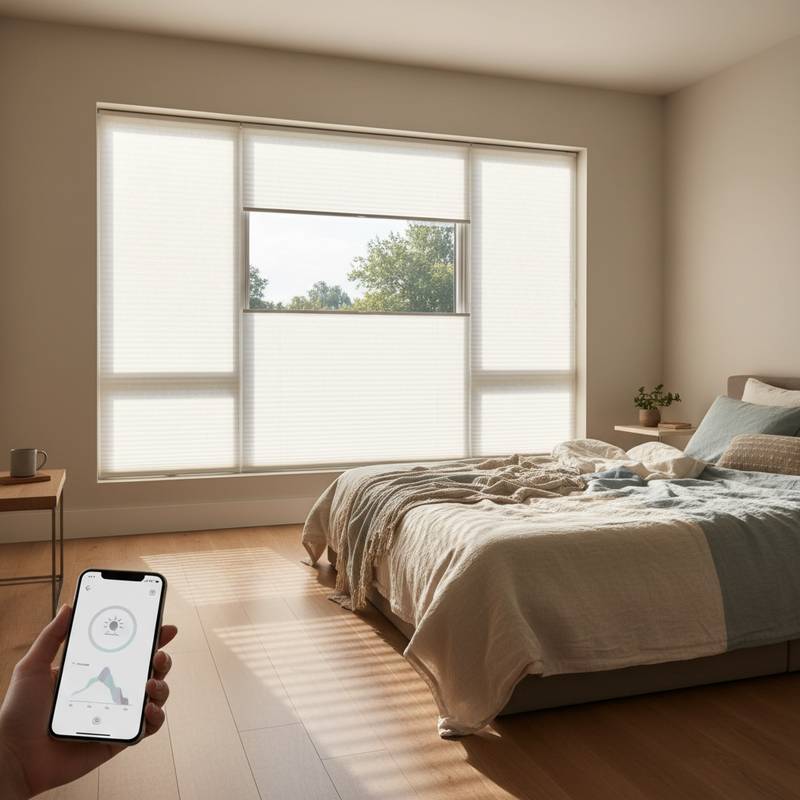Awakening to Ideal Natural Light
Picture this scenario: you stir awake as soft sunlight filters into your bedroom, calibrated to ease you into the day without abrupt intensity. No need for disruptive alarms or manual curtain adjustments. These smart blinds, attuned to your sleep patterns, deliver light precisely when your body signals readiness, fostering a serene start to your morning.
This innovation stems from advancements in home automation. By analyzing your rest cycles, the blinds create an environment that aligns with your biological clock. Users often report heightened alertness and reduced grogginess as a result.
Challenges of Inflexible Window Coverings
Conventional blinds remain fixed in position, leading to either prolonged darkness that delays waking or sudden brightness that jars the senses. For individuals with shift work or varying schedules, maintaining optimal light conditions proves labor-intensive. Disruptions in light exposure can unsettle the circadian rhythm, impacting sleep depth, emotional balance, and daily vitality.
Beyond immediate discomfort, inconsistent lighting contributes to broader health concerns. Research highlights how mismatched light patterns correlate with fatigue and diminished productivity. The core issue lies in the lack of adaptability, forcing users to conform to rigid setups rather than benefiting from responsive design.
How Adaptive Smart Blinds Operate
Positioned within the broader smart lighting ecosystem, these blinds transcend basic remote control. Advanced models incorporate sensors alongside integrations with sleep-monitoring devices and home networks to map your bedtime and wake times accurately. As patterns emerge, the system refines its operations to deliver tailored light management.
The process unfolds in clear steps:
- Establish a connection via Wi-Fi or a compatible smart hub to enable communication.
- Link the blinds to personal devices such as smartphones, wearables, or dedicated trackers that log sleep data.
- Allow the system to observe and adapt over days, incrementally adjusting openings to coincide with natural arousals and closures to facilitate restful evenings.
This integration operates seamlessly in the background. Forget daily manual interventions; the technology evolves with your lifestyle, promoting sustained well-being through subtle, intelligent support.
Selecting Suitable Smart Blinds
Evaluate options by weighing automation capabilities, system compatibility, and cost to find the best fit for your needs. Prioritize features like voice control and energy efficiency to maximize long-term value.
- Affordable retrofit: The SwitchBot Curtain Rod 2, priced at approximately $90, transforms existing drapes into smart setups. It supports Alexa and Google Home for voice commands and schedules adjustments via its app to align with sleep data.
- Balanced performer: IKEA Fyrtur Smart Shades, beginning at about $160, provide dependable motorized operation through the Dirigera hub. Battery-operated and whisper-quiet, they suit temporary living situations like rentals.
- Luxury investment: Lutron Serena Smart Shades, starting from $500, feature ultra-quiet motors, location-based triggers, and broad compatibility with platforms such as Apple HomeKit and Samsung SmartThings for precise sleep synchronization.
Consider your existing smart devices when choosing. Opt for blinds within the same platform to streamline controls and enable advanced features, like coordinating light with climate adjustments during sleep transitions.
Key Installation and Usage Factors
Setup complexity depends on the model. Opt for battery-powered units for straightforward, tool-free installation in most cases. Wired variants might necessitate electrician involvement, with total time ranging from one to three hours per window.
Measure your windows meticulously to ensure compatibility, particularly with non-standard or vintage frames. Test the motor's torque against your shade weight to avoid operational glitches.
Incorporate these blinds into a comprehensive wellness plan. Pair them with adjustable room lighting to reinforce circadian alignment, yielding benefits like steadier energy levels. Consistent use over weeks typically leads to more refreshed awakenings and faster sleep initiation.
Embracing the Benefits of Automated Light Control
As the blinds acclimate to your routines, the transition from mere utility to genuine enhancement becomes evident. Adjustments occur intuitively, reshaping your living space to nurture your well-being without effort. Should your schedule shift, simple app updates retrain the system promptly.
Begin by identifying priority windows, such as bedrooms or home offices. Establish a budget that accounts for potential add-ons like extenders. For complex setups, consult certified installers to guarantee smooth performance and integration.
Ultimately, these smart blinds harmonize technology with personal health needs. They cultivate environments where light serves as an ally, balancing rest and activity to elevate your daily experience.
